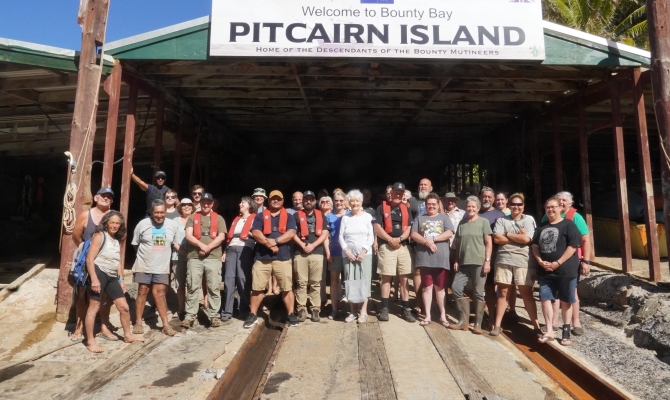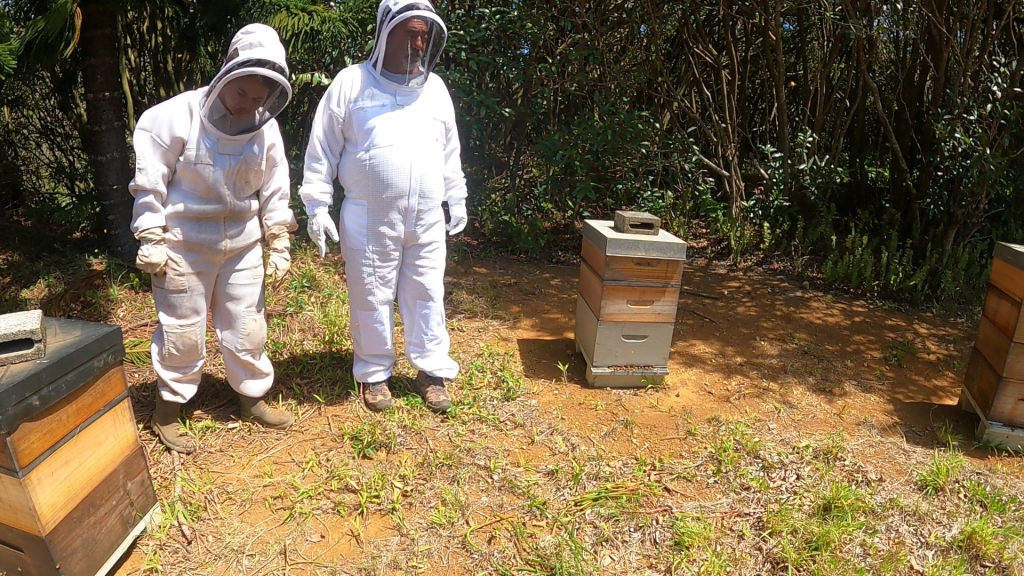
October 27, 2023: Following its landmark achievement of establishing one of the world’s largest Marine Protected Area, Pitcairn Island is once again stepping up its commitment to the environment.
This time, the small island with a big vision, is focusing on the preservation of its terrestrial environment, with help from the Secretariat of the Pacific Regional Environment Programme (SPREP) and the Pacific Community (SPC) under the European Union funded, PROTEGE Program.
This month, an 11-day mission led by Dominic Sadler, SPREP's PROTEGE Invasive Species Component Manager, was launched and marked the first ever SPREP delegation to Pitcairn Island.
“The goal was to conduct community consultations that would prioritize actions for the creation of a Territorial Invasive Species Strategy and Action Plan (TISSAP)” Mr. Sadler explains. “While Pitcairn Islands has engaged in conservation activities like eradications and weed management in the past, a coordinated strategy and action plan is crucial to streamlining their previous efforts and enhancing their success rate.”
Given Pitcairn’s primary export is honey, which recently faced production challenges, the delegation also included New Zealand Entomologist and beekeeper, Dr. Greg Shirley. Dr. Shirley collaborated with local residents to devise potential solutions, while also establishing contacts for Pitcairn beekeepers with the broader New Zealand beekeeping community for future support.
SPREP GEF6 Regional Invasive Species Coordinator and Technical Lead for the PRISMSS War on Weeds (WOW) Programme Josef Pisi, conducted an extensive weed identification survey on the island. Over 40 invasive and introduced plant species were recorded. Five low-incidence weeds were identified as priority for eradication, namely the Arrowhead vine (Syngonium auritum), Devil’s ivy (Epiremnum aurem), the Prickly ash (Zanthoxylum Americanum), Job’s tears (Coix lacryma-job).
“Raising awareness on what invasive weeds are there and their impact on the environment has been the rationale for the PRISMSS WOW programme” said Mr. Pisi. “The main message was for the community to keep a look out for these priority species and remove them immediately as soon as they start to spread rapidly as they have the ability to transform, damage or destroy ecosystem functions”.
Furthermore, two restoration sites were also identified to initiate a Resilient Ecosystems Resilient Communities (RERC) Programme for the Island. The aim of this programme is to restore high ecological priority sites that have biodiversity, climate resilience, socio-economic, health and cultural values to communities.

Lending further expertise to the mission, a dedicated Natural Enemies, Natural Solutions (NENS) PRISMSS partner Dr. Quentin Paynter from Manaaki Whenua Landcare Research also joined the delegation. He focused on identifying natural enemies already present on the island, as well as widespread invasive weeds that could respond well to bio control.
During the consultations, residents of Pitcairn expressed concerns regarding the invasive rose apple tree which they believe to be a contributing factor to reduced stream water levels due to its high-water absorption capacity and its surface roots which promote increased run-off. The implications of such a phenomenon could result in increased soil erosion and given Pitcairn’s abundance of endemic species there’s also a potential threat to the island’s native biodiversity.
Addressing these concerns, Mr. Sadler, emphasized the delegation's commitment to look further into these issues, drawing on the expert support of the Pacific Regional Invasive Species Management Support Services (PRISMSS).
As part of the follow-up, PRISMSS Protect Our Islands Programme lead and biosecurity expert, Dr. Monica Gruber, from Pacific Biosecurity in New Zealand, will be deployed to the island in December. She will spend time working with Pitcairn Island’s biosecurity team and support the formulation of the TISSAP.
“Our mission to Pitcairn has been a success and it was clear that the residents of Pitcairn Island are passionate about preserving and protecting their marine and terrestrial environment” said Mr. Sadler. “They have provided vital feedback that will form the backbone of their Territorial Invasive Species Strategy and Action Plan.”
Pitcairn, sharing many environmental challenges with other Pacific islands has the opportunity to collaborate with the wider region on invasive species management.
"Pitcairn's integration into Pacific networks, through SPREP and our larger regional network, is pertinent,” said Sadler. “While specific invasive species may differ, the fundamental issues resonate across the Pacific region”.